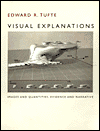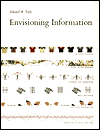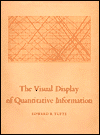
"Visual Explanations: Images and Quantities, Evidence and Narrative"
By Edward Tufte
Graphics Press,
158 pages

"Envisioning Information"
By Edward Tufte
Graphics Press,
128 pages

"The Visual Display of Quantitative Information"
By Edward Tufte
Graphics Press,
200 pages
|
Imagine being passionate about statistical graphs.
Caring deeply about the integrity of numbers. Liberating the "data prisons" and expressing "the poetry of visual information."
If the prospect sounds delightful, you're probably the sort of person who's already fallen in love with the books of Edward Tufte. If it sounds ridiculous, you're probably the sort of person who needs to read Tufte but doesn't know it yet.
In his three books, including the new "Visual Explanations," Tufte, a designer, statistician and Yale professor, presents a devastating critique of the way information is usually pictured to us. Bad graphics, according to Tufte, lie by distortion, obfuscate by omission and confuse by decoration. We have grown accustomed to awful information: The pie-charts Ross Perot liked to grin over in his infomercials; the pictograms of Russian soldiers that President Reagan's aides employed to show him the size of the Soviet threat; the misalignment of pictures and quantities in journals from the New York Times to Pravda.
![[Pravda graphic]](graphics/pravda970310.gif) From the cigarette pack Surgeon General's warning, rendered nearly illegible by its thick-rule border, to the endless parade of tax or budget charts that fail to adjust for inflation, Tufte is merciless toward the misleading -- not so much because he shares the popular prejudice about "lies, damned lies and statistics," but because he's irritated that we end up spending so much time deciphering bad designs when we could be exploring "the wonder of the data."
From the cigarette pack Surgeon General's warning, rendered nearly illegible by its thick-rule border, to the endless parade of tax or budget charts that fail to adjust for inflation, Tufte is merciless toward the misleading -- not so much because he shares the popular prejudice about "lies, damned lies and statistics," but because he's irritated that we end up spending so much time deciphering bad designs when we could be exploring "the wonder of the data."
Wonder? But aren't graphs and charts just dry compilations of boring statistics?
Ah, Tufte writes: "If the statistics are boring, then you've got the wrong numbers." By this he doesn't simply mean that the "right" numbers hold intrinsic interest because of their real-life impact in politics, finance, medicine, everywhere. He's arguing that inspired design can actually cause the meaningful "right" numbers to flash out from statistical murk, the way heat reveals the lemon-juice marks of a child's invisible-ink experiment.
This sounds like a kind of magic trick -- so it's not surprising to find a whole chapter in the new Tufte book devoted to graphic depictions of magicians' stunts. Only Tufte is studying the magician's tricks of indirection in order to refine the art of direction -- to learn "what not to do if our goal is truth-telling rather than illusion-making."
Tufte's trilogy -- the groundbreaking "The Visual Display of Quantitative Information" (1983), the follow-up "Envisioning Information" (1990) and the new "Visual Explanations" -- is definitive work, the kind of combination of criticism, history and teaching that rewards repeat readings over the years. His first book recalls George Orwell's classic essay "Politics and the English Language," and not only because it paraphrases Orwell's famous advice that writers should break his rules rather than "say anything outright barbarous": In Tufte's words, "It is better to violate any principle than to place graceless or inelegant marks on paper."
On a deeper level, Tufte shares Orwell's impatience with doublethink and humbuggery, his insight that bad thinking and bad expression travel in a pair, and his awareness that they are usually deployed in the service of some brand of propaganda. It's no coincidence that so many of Tufte's examples of deceitful charts illustrate politically charged issues like oil price rises and tax rates. One particular swarm of disinformation clusters around the oil-price spike of the late 1970s; Tufte traces wild exaggerations in the New York Times, the Washington Post and Time magazine, where charts decorated with barrels and rigs added to the confusion.
![[Next page]](graphics/tuftenext970310.gif) NEXT PAGE | GRAPHICS AREN'T FOR DUMMIES NEXT PAGE | GRAPHICS AREN'T FOR DUMMIES
Reprinted with the permission of Salon.com
|